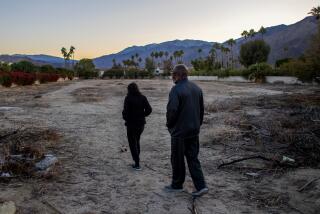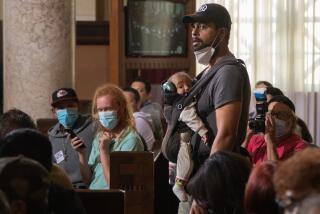New Orleans Rebuilding Plan Stirs Anger
NEW ORLEANS — Mayor C. Ray Nagin faced another hurricane Monday, this one of rage as residents stood to criticize his plan to rebuild New Orleans.
Nagin met with the Bring New Orleans Back commission that had outlined a broad framework for remaking the city after Hurricane Katrina -- its infrastructure, as well as its economy, cultural life and educational, health and criminal justice systems.
“We have worked tirelessly,” Nagin told the residents in presenting the plan. “It has been controversial in some respects, but I am pleased by the results.”
Seven months after the worst natural disaster in U.S. history, much of New Orleans remains a ghost town and thousands of families are unsure if they will be able to reconstruct their lives. Meanwhile, Congress still has not approved billions of dollars in federal reconstruction funds.
The public-comment session at the commission meeting Monday made clear that for the moment New Orleans is a city of rage.
Speakers, in their allotted three minutes, lambasted the commission for everything from their inability to rebuild their homes to, in one speaker’s case, the city’s unwillingness to replace street lights.
Albert Clark, a member of MERGE -- Movement to End Racism in Government and Everywhere -- called the commission a “racist, no-good rotten committee” whose members were of the “rich and ruling class” and did not reflect the city’s working classes. His comments brought applause.
Some speakers’ points were difficult to understand; others rambled. But almost everyone was mad, and few spoke quietly.
Wilbert “Chill” Wilson complained that his barber’s license was about to be revoked, though he’d put in 140 days of free haircutting after the hurricane. Another man explained how he’d gone to several of the mayoral debates and was able to speak to a few of the candidates vying to replace Nagin. The man seemed to be getting to a relevant point when he ran out of time.
Cora Charles said she had worked and paid taxes for 35 years and owned her Lower 9th Ward home that was destroyed in the flooding after Katrina. She criticized Nagin for suggesting that people in flood zones could rebuild, but at their own risk.
Pam Dashiell, also of the Lower 9th Ward, was heartily applauded when she said that the Katrina disaster was man-made. “Had the Corps of Engineers not been negligent, there would have been no disaster.”
Watching it all was Nolan Marshall, a city council candidate running for the district encompassing the Lower 9th Ward and New Orleans East, two of the worst-hit areas.
“Everybody’s doing the best they can, but a lot of people are hurting right now,” Marshall said outside the session.
The poor, black neighborhoods of New Orleans have been neglected for years and thus “people don’t trust government,” Marshall said. “People aren’t hearing what they want to hear. This is an opportunity for public venting.”
Babatunji Ahmed said that black tradesmen were being left out of the rebuilding and that jobs they should have were going to thousands of workers who he said contractors had brought in from Texas and elsewhere.
“We want our black people back,” said Ahmed, a carpenter, his voice rising above the applause. “We want our workers back to rebuild our city. It was us on the roofs. Somebody is trying to keep us away from the economic pie.”
Even City Councilwoman Cynthia Willard-Lewis gradually increased her volume and rage until she was yelling, though what she said appeared to support Nagin and the commission plan.
“You were listening, Mr. Mayor, as you traveled all over this city,” she said.
“When you go to Baton Rouge, you are going to fight. And when you go to Washington, D.C., you are going to point out that the most devastated section of the parts that we serve ... we ask for the same level of attention and the same economic restoration. Let the black part of the city of New Orleans receive the percentage of resources that they deserve.”
After the meeting, Cesar R. Burgos, an attorney who chaired the commission’s Cultural Life panel, said that the plan was comprehensive, and that those at the meeting overlooked its positive points that dealt with the city’s needs as it was rebuilt.
But, Burgos said, he understood the people’s emotions.
“There are people out there who are still suffering and they just have a necessity to vent,” he said. “If you came up with a hundred plans up there, the reactions would be similar.”
More to Read
Sign up for Essential California
The most important California stories and recommendations in your inbox every morning.
You may occasionally receive promotional content from the Los Angeles Times.










